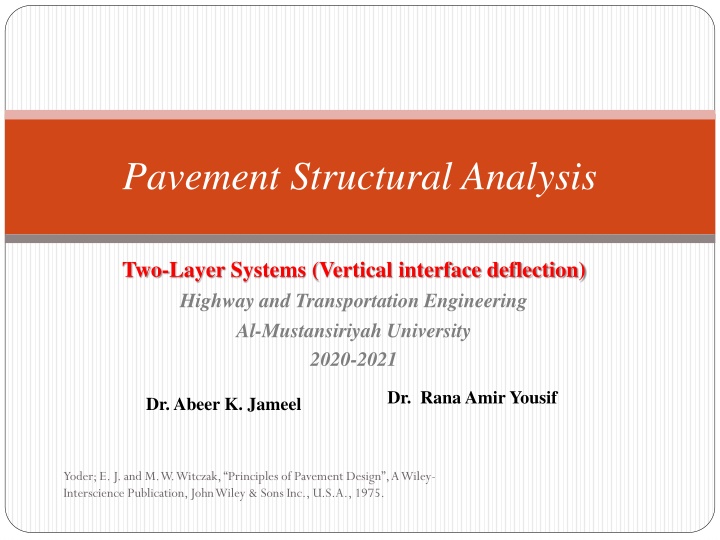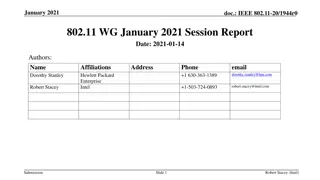
Structural Analysis of Two-Layer Pavement Systems
This study delves into the vertical interface deflection criteria for two-layer pavement systems in highway and transportation engineering. By analyzing the deflection factor and various parameters such as the modulus ratio and thickness-radius ratio, the design criteria for two-layer systems are explored. Steps to solve the vertical interface deflection are also outlined in detail.
Uploaded on | 0 Views
Download Presentation

Please find below an Image/Link to download the presentation.
The content on the website is provided AS IS for your information and personal use only. It may not be sold, licensed, or shared on other websites without obtaining consent from the author. If you encounter any issues during the download, it is possible that the publisher has removed the file from their server.
You are allowed to download the files provided on this website for personal or commercial use, subject to the condition that they are used lawfully. All files are the property of their respective owners.
The content on the website is provided AS IS for your information and personal use only. It may not be sold, licensed, or shared on other websites without obtaining consent from the author.
E N D
Presentation Transcript
Pavement Structural Analysis Two-Layer Systems (Vertical interface deflection) Highway and Transportation Engineering Al-Mustansiriyah University 2020-2021 Dr. Rana Amir Yousif Dr. Abeer K. Jameel Yoder; E. J. and M. W. Witczak, Principles of Pavement Design , A Wiley- Interscience Publication, John Wiley & Sons Inc., U.S.A., 1975.
References Nicholas J. Garber and Lester A. Hoel. Traffic and Highway Engineering , Fourth Edition. Yoder; E. J. and M. W. Witczak, Principles of Pavement Design , A Wiley- Interscience Publication, John Wiley & Sons Inc., U.S.A., 1975. Yaug H. Huang, Pavement Analysis and Design , Prentic Hall Inc., U.S.A., 1993. AASHTO Guide for Design of Pavement Structures 1993 , AASHTO, American Association of State Highway and Transportation Officials, U.S.A., 1993. Oglesby Clarkson H., HighwayEngineering , John Wiley & Sons Inc., U.S.A., 1975. Yoder; E. J. and M. W. Witczak, Principles of Pavement Design , A Wiley- Interscience Publication, John Wiley & Sons Inc., U.S.A., 1975.
Two-Layer Systems Vertical Interface Deflection: The vertical interface deflection has also been used as a design criterion. Figure 2.19 can be used to determine the vertical interface deflection in a two-layer system (Huang, 1969c) . The deflection is expressed in terms of the deflection factor F by: (2.16) Yoder; E. J. and M. W. Witczak, Principles of Pavement Design , A Wiley- Interscience Publication, John Wiley & Sons Inc., U.S.A., 1975.
Two-Layer Systems ( (Vertical Interface Deflection) Yoder; E. J. and M. W. Witczak, Principles of Pavement Design , A Wiley- Interscience Publication, John Wiley & Sons Inc., U.S.A., 1975.
Two-Layer Systems ( (Vertical Interface Deflection) The deflection factor is a function of: 1.The modulus ratio El/E2. 2. Thickness radius ratio h1/a. 3. r/a. Where : r:is the radial distance from the center of loaded area. Yoder; E. J. and M. W. Witczak, Principles of Pavement Design , A Wiley- Interscience Publication, John Wiley & Sons Inc., U.S.A., 1975.
Two-Layer Systems ( (Vertical Interface Deflection) Steps to Solve Two-Layer Systems (Vertical Interface Deflection): Step 1 Find value. Find value. Find value. Yoder; E. J. and M. W. Witczak, Principles of Pavement Design , A Wiley- Interscience Publication, John Wiley & Sons Inc., U.S.A., 1975.
Two-Layer Systems ( (Vertical Interface Deflection) Steps to Solve Two-Layer Systems: Step 2 As example (if = 4 , = 1 and = 1.5 ) from Figure 2.19 please follow the chart Then F= 0.3 can obtain. 1 Yoder; E. J. and M. W. Witczak, Principles of Pavement Design , A Wiley- Interscience Publication, John Wiley & Sons Inc., U.S.A., 1975. 2
Two-Layer Systems ( (Vertical Interface Deflection) Example: Figure 2.20 shows a set of dual tires, each having contact radius 4.52 in . (115 mm) and contact pressure 70 psi (483 kPa) . The center-to- center spacing of the dual is 13 .5 in . (343 mm) . Layer 1 has thickness 6 in . (152 mm) and elastic modulus 100,000 psi (690 MPa) ; layer 2 has elastic modulus 10,000 psi (69 MPa) . Determine the vertical deflection at point A, which is on the interface beneath the center of one loaded area .? Yoder; E. J. and M. W. Witczak, Principles of Pavement Design , A Wiley- Interscience Publication, John Wiley & Sons Inc., U.S.A., 1975.
Two-Layer Systems ( (Vertical Interface Deflection) Solution: Given = 100,000/10,000 = 10 = 6 / 4.542 = 1.33 The deflection factor at point A due to the left load where : = 0 from Figure 2.19 F = 0.56 Yoder; E. J. and M. W. Witczak, Principles of Pavement Design , A Wiley- Interscience Publication, John Wiley & Sons Inc., U.S.A., 1975. E1/E2
Two-Layer Systems ( (Vertical Interface Deflection) Solution: The deflection factor at point A due to the right load where : = 13.5 / 4.52 = 2.99 from Figure 2.19 F = 0.28 By superposition F = 0.56 + 0.28 = 0.84 From Eq. 2.16 w = 70 * 4 .52/10,000 * 0.84 = 0.027 in . (0.69 mm) Yoder; E. J. and M. W. Witczak, Principles of Pavement Design , A Wiley- Interscience Publication, John Wiley & Sons Inc., U.S.A., 1975. E1/E2
Two-Layer Systems Dr. Rana Amir Yousif & Dr. Abeer K. Jameel Yoder; E. J. and M. W. Witczak, Principles of Pavement Design , A Wiley- Interscience Publication, John Wiley & Sons Inc., U.S.A., 1975.



















